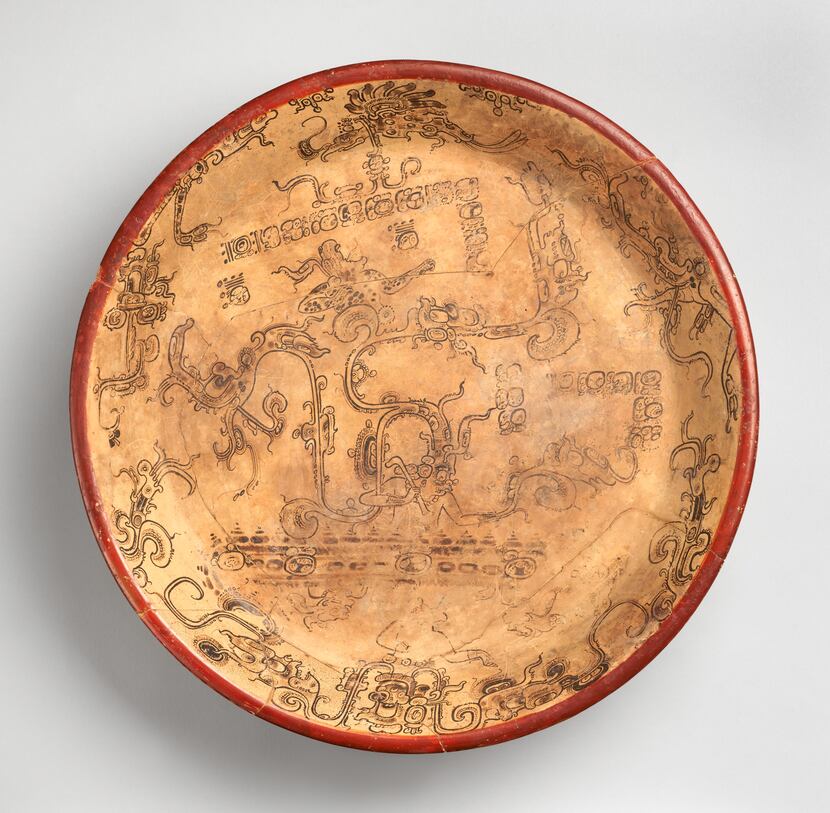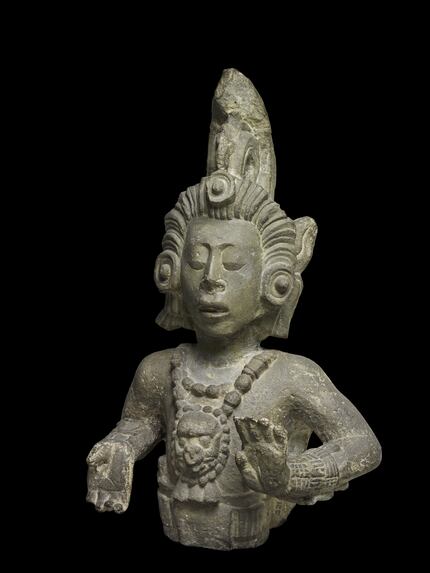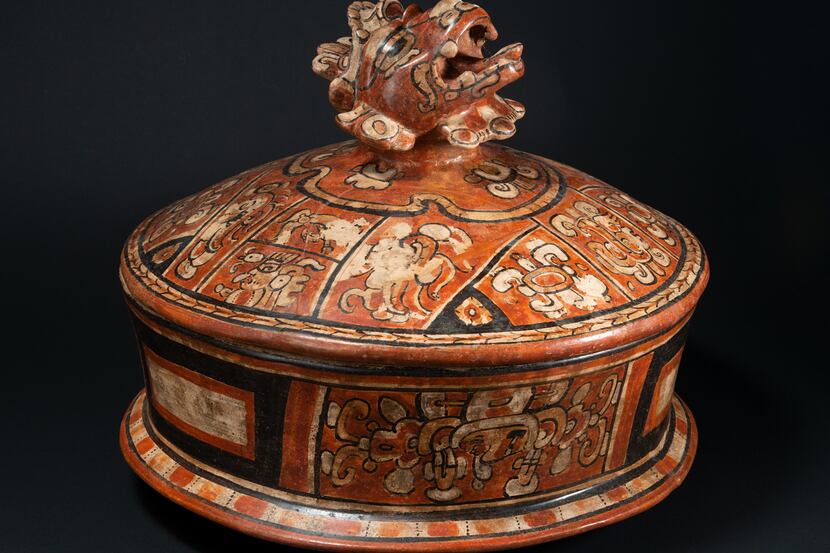Showcasing almost 100 relief stone sculptures and painted ceramic vessels from museums across Guatemala, Mexico, Europe and the U.S., an exhibition now at the Kimbell Art Museum uses these ancient artworks to retell the stories of the gods of the Maya civilization.
The artworks mostly date to around the eighth century, from the peak of the Maya’s Classic period. Some have been recently unearthed from archaeological sites, while others have been painstakingly restored after damage or neglect.
A fine example of the latter is the 5-foot-tall throne from Piedras Negras, Guatemala, restored by an international team. A ruler would sit at the center of the stone throne between two carved figures, possibly the ruler’s parents.
Like their counterparts in the pantheons of Greece, Rome, Egypt and India, the Maya gods were closely associated with the ruling class, and demonstrating devotion to the gods was an important part of a ruler’s legitimacy. In the eighth-century carved stone slab from Calakmul, Mexico, the ruler wears a headdress, cape and other garments that show his sacred office. Other works depict the social aspects of court life, as when a ruler reinforces his status by throwing a banquet at which visiting dignitaries pay him tribute.
Sometimes the rulers even seem to usurp the gods. A limestone panel from the Cleveland Museum of Art shows a royal woman with a fabulous headdress holding a small wriggling K’awiil (lightning god) in her hand. Kʼawiil also appears on a remarkable, razor-sharp flint, riding in a canoe with human passengers on a supernatural voyage.

Carefully lit and arranged, the show attempts to re-create the sense of awe and wonder that must have accompanied the objects in their original royal and sacred contexts. It is almost possible to hear the sounds of the forest and smell the burning incense and steaming cacao that would have been part of the original experience.
Keying on symbols that were fundamental to Mayan life — sun and rain, night and day, maize (corn) and the jaguar — the curators retell the myths of the Maya gods, and how their dramatic adventures bridged the natural and social worlds.
Nighttime, for example, was naturally associated with scary creatures, like the monsters that adorn an intricately carved rectangular ceramic box from Guatemala. On a ceramic plate from the Metropolitan Museum of Art, the feisty Chahk (god of rain and storm) is posed like a mad scientist over his workbench, bringing other members of the pantheon into being.

By contrast, the sun god Ajaw K’in, on a panel fragment from Palenque, Mexico, is upright, strong and forceful. Also associated with the dawn was the howler monkey, whose hearty cry would greet the morning. On a lidded vessel, the monkey’s head serves as a handle, so that dinner guests could imagine him crying out as the steaming entree beneath was revealed to the table.

The Maize God, one of the main figures in the pantheon, stays forever young and immortal, despite endless trials. He appears as an elegant youth in a 3-foot-tall limestone sculpture from Copan, Honduras. As leaves and kernels sprout from his head, he embodies the connections among nature, power and human life. He is also seen serenely reclining on a ceramic cup from Calakmul that depicts the cycle of his rebirth, happy and at leisure as he watches the world around him.
Some of the works show great mechanical ingenuity, as in the so-called whistling vessel, where water poured into the chamber would make a whistling sound. In this vessel, the whistle would appear to come from the great bird-god who is perched proudly opposite a young man, kneeling and apparently paying tribute.
The decipherment of Maya hieroglyphs has been developing since the last century and is an ongoing project. But it has revealed the names of some of the artists whose work is represented here — unusually for ancient art, Maya sculptors often signed their work.
The show also reminds us that Maya culture continues to thrive. Toward the end of the exhibition is a video of a present-day “dance of the macaws,” a Mayan religious ritual, in a highlands town of Guatemala. It gives viewers a glimpse into the worlds of sound and motion that once surrounded these silent stones.
Details
Lives of the Gods: Divinity in Maya Art is at the Kimbell Art Museum, 3333 Camp Bowie Blvd., Fort Worth, through Sept. 3. Tuesdays through Saturdays from 10 a.m. to 5 p.m., Fridays noon to 8 p.m., Sundays noon to 5 p.m. $18 adults, $16 seniors, K-12 educators, students and military, $14 ages 6-11, free for children under 6 and $3 for SNAP recipients. Half-price admission on Tuesdays and after 5 p.m. on Fridays. kimbellart.org, 817-332-8451.

/cloudfront-us-east-1.images.arcpublishing.com/dmn/OZNLPQJDDNH65N5SMPVAKAIFEI.jpg)
/cloudfront-us-east-1.images.arcpublishing.com/dmn/GYNAKXQH75BT5LLTWLMNITPVVQ.jpg)
/cloudfront-us-east-1.images.arcpublishing.com/dmn/GQPKPNK6IBHDNEONOHKAK2SY3M.jpg)
/cloudfront-us-east-1.images.arcpublishing.com/dmn/LMSVKNBXIZBTDLYBU345RDQ2IU.jpg)
/cloudfront-us-east-1.images.arcpublishing.com/dmn/ISURAQCY2BDRFC6EETOOISJPO4.jpg)
